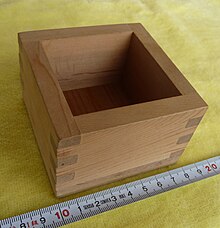Ge (unit): Difference between revisions
m Added {{no footnotes}} tag to article (TW) |
Use in rice cookers |
||
| Line 8: | Line 8: | ||
As a unit expressing volume, one gō is equivalent to a tenth of a [[Japanese units of measurement#Volume|shō]]. This is approximately equal to 0.1809 [[liter]]s. |
As a unit expressing volume, one gō is equivalent to a tenth of a [[Japanese units of measurement#Volume|shō]]. This is approximately equal to 0.1809 [[liter]]s. |
||
Although it is no longer used officially, [[rice]] and [[sake]] are often measured in ''gō''. As a rule of thumb, one ''gō'' is equivalent to about 150 [[gram]]s of Japanese short grain rice. A ''gō'' is 1/1000 of a ''[[koku]]'', the [[fundamental unit|base unit]] which was historically defined as the amount of rice needed to feed one person for a year. It is a very old unit of measurement and recently there has been some attempts of revival which have met with success; {{Fact|date=October 2007}} several more things are now being measured in ''gō'' like traditional Japanese fish (especially the dangerous [[Fugu]]) and several restaurants have re-instated it as part of a more traditional way of viewing the country's culture. |
Although it is no longer used officially, [[rice]] and [[sake]] are often measured in ''gō''. For example, [[rice cooker]]s come with a 1 ''gō'' (180mL) measuring cup used to indicate the serving size for one person. As a rule of thumb, one ''gō'' is equivalent to about 150 [[gram]]s of Japanese short grain rice. A ''gō'' is 1/1000 of a ''[[koku]]'', the [[fundamental unit|base unit]] which was historically defined as the amount of rice needed to feed one person for a year. It is a very old unit of measurement and recently there has been some attempts of revival which have met with success; {{Fact|date=October 2007}} several more things are now being measured in ''gō'' like traditional Japanese fish (especially the dangerous [[Fugu]]) and several restaurants have re-instated it as part of a more traditional way of viewing the country's culture. |
||
The Japanese gō is distinct from the Chinese unit gě, although both are written with the same character. The gě is also a unit of volume, but its size is a tenth of a [[wiktionary:peck|peck]], or roughly 0.881 liters. |
The Japanese gō is distinct from the Chinese unit gě, although both are written with the same character. The gě is also a unit of volume, but its size is a tenth of a [[wiktionary:peck|peck]], or roughly 0.881 liters. |
||
Revision as of 21:03, 10 December 2013
This article includes a list of references, related reading, or external links, but its sources remain unclear because it lacks inline citations. (February 2013) |

The gō (合) is a traditional Japanese unit of area and volume. It expresses a tenth of a particular quantity.
As a unit expressing area, one gō is equivalent to a tenth of a bu or tsubo. This is approximately equal to 0.3306 m².
As a unit expressing volume, one gō is equivalent to a tenth of a shō. This is approximately equal to 0.1809 liters.
Although it is no longer used officially, rice and sake are often measured in gō. For example, rice cookers come with a 1 gō (180mL) measuring cup used to indicate the serving size for one person. As a rule of thumb, one gō is equivalent to about 150 grams of Japanese short grain rice. A gō is 1/1000 of a koku, the base unit which was historically defined as the amount of rice needed to feed one person for a year. It is a very old unit of measurement and recently there has been some attempts of revival which have met with success; [citation needed] several more things are now being measured in gō like traditional Japanese fish (especially the dangerous Fugu) and several restaurants have re-instated it as part of a more traditional way of viewing the country's culture.
The Japanese gō is distinct from the Chinese unit gě, although both are written with the same character. The gě is also a unit of volume, but its size is a tenth of a peck, or roughly 0.881 liters.
References
- Matsumura, Akira (1995). Daijirin. Sanseidō. ISBN 4-385-14009-X.
